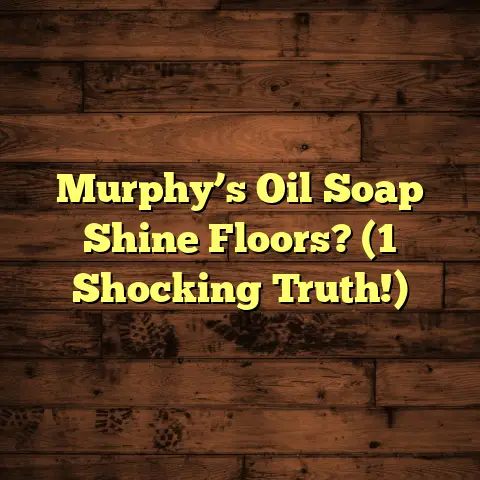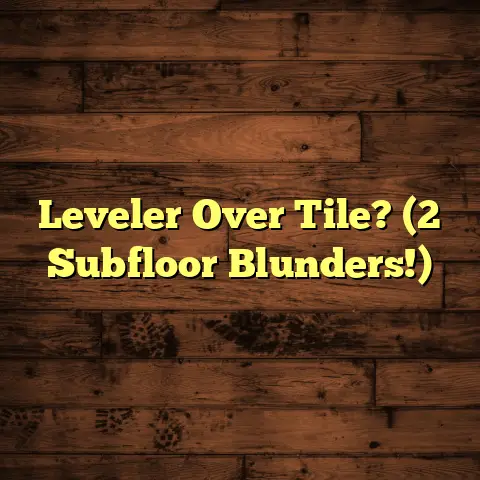Fix Wood Scratches Without Sanding? (4 Methods!)
I’m a flooring contractor, and let me tell you, I’ve seen my fair share of scratched-up wood floors.
It’s a common problem, and the good news is you don’t always need to go nuclear with sanding.
Imagine this: you’ve just moved into your dream home, or perhaps you’ve finally invested in that stunning hardwood flooring you’ve always wanted.
The rich, warm tones and the natural grain of the wood bring a sense of elegance to your space.
But then, disaster strikes.
A misplaced piece of furniture, an excited pet, or even a simple accident leaves unsightly scratches on your beautiful wood floor.
The initial shock of seeing those scratches can be disheartening.
You know that traditional repair methods often involve sanding down the surface, which can be time-consuming, messy, and may require professional help.
Not to mention, sanding can alter the finish and texture of your wood, leaving you with more than just scratches to worry about.
That’s why I’m sharing my go-to methods for fixing those pesky scratches without the dreaded sanding.
Ready to learn how to bring your floors back to life? Let’s dive in!
1. Understanding the Types of Scratches
Before we get to the fixes, it’s important to understand what we’re dealing with.
Not all scratches are created equal.
1.1 Surface Scratches vs. Deep Scratches
Think of it this way: a surface scratch is like a paper cut, while a deep scratch is more like a… well, a deeper cut!
Surface Scratches: These are light, often only affecting the finish layer of your wood.
You might see them as a hazy or cloudy mark.Deep Scratches: These penetrate through the finish and into the wood itself.
You can usually feel them with your fingernail.
The type of scratch dictates the best approach.
A light scratch might only need a simple concealer, while a deeper one might require a bit more filling.
1.2 Assessing Damage
Take a good look at your floor.
How many scratches are there?
How deep are they?
Are they concentrated in one area, or scattered?
Run your finger over the scratch. Can you feel it easily?
Does it look like it’s just in the finish, or does it go deeper?
Knowing the extent of the damage helps you choose the right method and manage your expectations.
2. Method 1 – Using a Walnut
Yep, you read that right!
A simple walnut can be surprisingly effective for light scratches.
2.1 The Science Behind It
Walnuts are packed with natural oils.
These oils can help to fill in the scratch and blend it with the surrounding wood.
Plus, the walnut’s color can help to camouflage the scratch, making it less noticeable.
Think of it as a natural stain and filler in one!
2.2 Step-by-Step Instructions
Here’s how to work your walnut magic:
-
Gather Materials: You’ll need a walnut (shelled, of course!), a soft cloth, and optionally, a bit of mineral oil.
-
Prep the Walnut: Break the walnut in half.
Rub-a-Dub-Dub: Gently rub the broken walnut meat along the scratch, going with the grain of the wood.
Apply a bit of pressure to release the oils.Buff It Out: Use your soft cloth to buff the area.
This will help to spread the oils and remove any walnut residue.(Optional) Mineral Oil: If needed, add a tiny dab of mineral oil to your cloth and buff again.
This can help to further blend the scratch.
Pro Tip: Try it on an inconspicuous area first to make sure the walnut color is a good match for your floor.
2.3 Pros and Cons
Pros:
- Super easy and inexpensive.
- Uses natural materials.
- Works well for light surface scratches.
Cons:
- Not effective for deep scratches.
- The walnut color might not be a perfect match for all wood types.
- The effect is temporary and may need to be reapplied.
3. Method 2 – Using a Furniture Marker or Crayon
Furniture markers and crayons are designed specifically for touching up wood furniture, and they can work wonders on floors too!
3.1 Choosing the Right Marker
The key here is to find a color that closely matches your floor’s finish.
Take a close-up photo of your floor and bring it to the hardware store.
Compare the marker colors to your photo in natural light to get the best match.
Also, consider the sheen.
If your floor has a glossy finish, choose a marker with a similar sheen.
3.2 Step-by-Step Instructions
Clean the Area: Use a damp cloth to clean the area around the scratch.
Make sure it’s dry before you start.Apply the Marker/Crayon: Carefully apply the marker or crayon directly to the scratch, following the grain of the wood.
Don’t overdo it!
You can always add more, but it’s harder to remove excess.Blend It In: Use a clean, soft cloth to gently blend the color into the surrounding wood.
Use circular motions.-
Wipe Away Excess: If you’ve applied too much, dampen your cloth slightly and gently wipe away the excess color.
3.3 Pros and Cons
Pros:
- Easy to use and readily available.
- Comes in a wide range of colors to match different wood finishes.
- Provides a more durable fix than the walnut method.
Cons:
- Finding the perfect color match can be tricky.
- Can look unnatural if the color is too different from the surrounding wood.
- May not be effective for deep scratches.
4. Method 3 – DIY Vinegar and Olive Oil Mixture
This is an old-school remedy that can help to nourish the wood and minimize the appearance of scratches.
4.1 The Properties of Vinegar and Olive Oil
Vinegar is a mild acid that can help to clean and restore the wood’s finish.
Olive oil is a natural moisturizer that can help to nourish the wood and make it look more vibrant.
Together, they create a powerful cleaning and restoring solution.
4.2 Step-by-Step Instructions
Mix It Up: In a spray bottle, mix equal parts white vinegar and olive oil.
I usually go for 1/4 cup of each.-
Spray and Buff: Lightly spray the mixture onto the scratched area.
Buff with Love: Use a soft cloth to buff the area in circular motions.
Apply a bit of pressure.-
Let It Dry: Allow the mixture to sit for a few minutes, then buff again with a clean, dry cloth.
4.3 Pros and Cons
Pros:
- Uses natural ingredients.
- Inexpensive and easy to make.
- Can help to clean and restore the overall appearance of the wood.
Cons:
- The results may be subtle, especially on deep scratches.
- The vinegar smell can be off-putting to some.
- May leave the floor feeling slightly oily if not buffed properly.
5. Method 4 – Using a Wood Filler or Putty
For deeper scratches, you might need to bring in the big guns: wood filler or putty.
5.1 Understanding Wood Fillers
Wood fillers are designed to fill in gaps and imperfections in wood.
They come in different types, including:
- Water-Based Fillers: Easy to use and clean up, but may shrink slightly as they dry.
- Solvent-Based Fillers: More durable and water-resistant, but can be more difficult to work with and have a strong odor.
- Epoxy Fillers: The strongest and most durable option, but also the most expensive and complex to use.
For most floor scratches, a water-based filler is a good choice.
5.2 Step-by-Step Instructions
-
Clean the Scratch: Use a small brush or vacuum to remove any debris from the scratch.
Apply the Filler: Use a putty knife to apply the wood filler to the scratch.
Overfill it slightly, as the filler will shrink as it dries.Let It Dry: Allow the filler to dry completely according to the manufacturer’s instructions.
This could take several hours or even overnight.-
Sand It Smooth: Once the filler is dry, use fine-grit sandpaper (220-grit or higher) to sand it down until it’s flush with the surrounding wood.
Stain and Finish: If necessary, apply a wood stain to match the color of your floor.
Then, apply a coat of polyurethane or other clear finish to protect the repair.
5.3 Pros and Cons
Pros:
- Provides a durable and long-lasting repair.
- Can be used to fill in deep scratches and gouges.
- Can be stained to match the color of your floor.
Cons:
- Requires more skill and effort than the other methods.
- Can be messy and time-consuming.
- If not done properly, the repair can be noticeable.
6. Tips for Preventing Future Scratches
Of course, the best way to deal with scratches is to prevent them in the first place!
6.1 Protective Measures
- Area Rugs: Place area rugs in high-traffic areas to protect your floors from wear and tear.
- Furniture Pads: Attach felt pads to the legs of all your furniture to prevent scratches when moving them.
- Door Mats: Use door mats at all entrances to trap dirt and debris before they can be tracked onto your floors.
- Pet Care: Keep your pets’ nails trimmed to minimize scratching.
6.2 Regular Cleaning
Regular cleaning is essential for preventing scratches.
- Sweep or Vacuum Regularly: Use a soft-bristled broom or a vacuum with a floor brush attachment to remove dirt and debris.
- Damp Mop: Damp mop your floors regularly with a pH-neutral cleaner designed for wood floors.
Avoid using excessive water, as it can damage the wood. - Avoid Harsh Chemicals: Don’t use harsh chemicals or abrasive cleaners on your wood floors, as they can damage the finish.
Conclusion: Restoring Your Wood Floors
So there you have it: four effective methods for fixing wood scratches without sanding!
I know it can be disheartening to see those imperfections on your beautiful floors, but don’t despair.
With a little effort and the right techniques, you can restore your wood floors to their former glory.
Remember to assess the type and severity of the scratches before choosing a method.
Start with the simplest approach first, and work your way up to more complex solutions if needed.
And most importantly, take steps to prevent future scratches by implementing protective measures and maintaining a regular cleaning routine.
Your wood floors are an investment, and with proper care, they can last for generations.
So go ahead, give these methods a try, and enjoy the beauty of your scratch-free floors!
Happy fixing!





